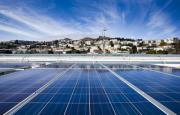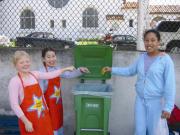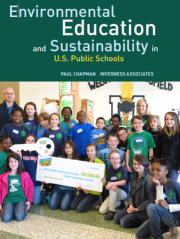Hawaii’s Environmental Sustainability Movement
Emerald Islands, Ocean Blue:
Hawaii’s Environmental Sustainability Movement
Flying into Hawaii in January for a week of school visits, I was quickly reminded of why this state is in the vanguard of our nation’s environmental sustainability movement. From the air, Hawaii’s islands appear as emeralds surrounded by fringe collars of white, dotting the vast blue ocean of the Mid-Pacific. Hawaii is further from the continental landmass than anywhere on earth, and this distance and sense of isolation shapes a consciousness among Hawaiians that their fragile ecosystem is at risk, and that they must take urgent action to protect it. The islands were first populated over 1500 years ago by wayfaring Polynesians who navigated thousands of miles in long, double-hulled ships, guided only by the sun, the moon, the stars and the currents, a heroic story that is being retold today by Nainoa Thompson, a graduate of the Punahou School. As the ancient Hawaiian proverb says, “The island is the canoe, the canoe is the island.”
The strength of Hawaii’s K-12 environmental movement comes in part from the leadership of the Hawaii Association of Independent Schools and the unique partnerships they have formed with the State Department of Agriculture and the Ulupono Initiative.  As the membership organization for over 100 private-independent schools, and through collaboration with many public schools, HAIS has stimulated the development of Hawaii as an environmental leader. In addition to reporting on the HAIS Grow Hawaii initiative, I will also offer case studies of five schools I visited that are going green, which HAIS Associate Director Roberta Bishop thoughtfully arranged: Punahou School, Palolo Elementary School, Eva Makai Middle School, Hawaii Pacific Academy, and La Pietra-Hawaii School for Girls.
As the membership organization for over 100 private-independent schools, and through collaboration with many public schools, HAIS has stimulated the development of Hawaii as an environmental leader. In addition to reporting on the HAIS Grow Hawaii initiative, I will also offer case studies of five schools I visited that are going green, which HAIS Associate Director Roberta Bishop thoughtfully arranged: Punahou School, Palolo Elementary School, Eva Makai Middle School, Hawaii Pacific Academy, and La Pietra-Hawaii School for Girls.
Founded in 2010, Grow Hawaii (www.growhi.org) began with the vision of long-time HAIS executive director Robert Witt, and the partnership with the Departments of Education and Agriculture and the Ulupono Initiative that he helped to form. Grow Hawaii “seeks to enrich the educational dialogue among all private and public schools statewide concerning the urgency of growing food in the islands.” Importing over 85% of its food, Hawaii is aware of its vulnerability and sees school garden and food programs as a way to “create life-long ‘buy local, eat local’ consumers who have a better understanding of their relationship to food.” The program is led by Jenna Ishii, an energetic environmental educator, and Kendra Ozaki, an experience Waldorf school educator, and now includes 15 public, private and charter schools from several islands. Grow Hawaii also supports a Hui or network of schools promoting schools gardens and nutritious food programs from throughout the islands.
The program is led by Jenna Ishii, an energetic environmental educator, and Kendra Ozaki, an experience Waldorf school educator, and now includes 15 public, private and charter schools from several islands. Grow Hawaii also supports a Hui or network of schools promoting schools gardens and nutritious food programs from throughout the islands.
The Hawaii school garden movement got a boost when the staff from the Center for Ecoliteracy in Berkeley, CA, Zenobia Barlow, Carolie Sly, and Karen Brown, facilitated a three-day workshop in 2010 that helped shape the vision for a statewide organization. As one participant, Nancy Redfeather, recalled, the group reached consensus on a simple goal: A garden in every school, a garden teacher in every garden, and a fully integrated curriculum. (Center for Ecoliteracy, Alice Lee Tebo, “Dispatch from Hawaii: Supporting the Growing School Garden Movement,” www.ecoliteracy.org) Within months a new group, the Hawaii Farm to School and School Garden Hui, coalesced. The mission of that group is “to inspire and empower Hawaii’s people to take an active and conscious role in restoring our relationship to food, farming and the environment, improving students health; and raising academic standards.” (www.hawaiischoolgardenhui.org)
After speaking to a group of educators, government officials, and environmental educators at luncheon hosted by Punahou School about my own work to document the environmental sustainability movement in my book, Greening America’s Schools (NAIS, 2012), it was my good fortune to talk with leaders of the Hui. Their mission is “inspire and empower Hawaii’s people to take an active and conscious role in restoring our relationship to food, farming, and the environmental; improving student health; and raising academic achievement.” (www.hawaiischoolgardenhui.org) The group includes the leadership of the garden and food networks on Hawaii Island, Kauai, Oahu, Maui, and Molokai. Already the Hawaiian school and garden network is breaking new ground. They have established a commitment to on-going professional development, featuring recent workshops and talks on the impact of plastics on the oceans and how to green your school. Determined to demonstrate that gardening is not a distraction from the purpose of education, the have assembled a website with resources on everything from nutrition, obesity, and mental health to research on how garden programs can be associated with improved academic achievement.
Grow Hawaii recently hosted a school chef’s demonstration table on gardening as an academic subject, and they are exploring setting up a direct farm to school procurement plan.
Hawaii’s leadership role became even more clear when I met the leaders of Hawaii’s just-completed effort to develop an Environmental Literacy Plan. Project Manager Michelle Jones and Lead Writer Pauline Sato presented me with their report, which aims to “support a growing movement—locally and nationally—to improve education in schools through environmental education (EE), which builds environmental literacy skills. The ninth state in the country to produce such a plan, Hawaii is clearly leading the way forward. (http://heea.org/core/item/page.aspx?s=95217.0.0.89929)
The Hawaii sustainability movement is focused on dramatic changes in energy consumption, as well. Faced with severe economic hardship, the state’s education budget has declined 6.5% in five years. To save money, the Department of Education, led by Assistant Superintendent Randy Moore, has aggressively pushed renewable solar power and energy conservation for schools. The good news is that usage fell from 155 million kwh to 135 million kwh, a 14% decrease over four years; the bad news is that rapidly rising electricity costs pushed the overall budget from $32.5 million to $40 million, a 23% increase. Without the Department’s efforts, those costs would have been significantly higher. (Honolulu Star-Advertiser, 1/20/12, A23)
The larger Hawaiian environmental sustainability is focused on the foundations of green schools: energy efficiency, healthy operations, an ecological curriculum, healthy food and gardens, and student empowerment. The schools are clearly setting an example for the rest of the country to follow.







